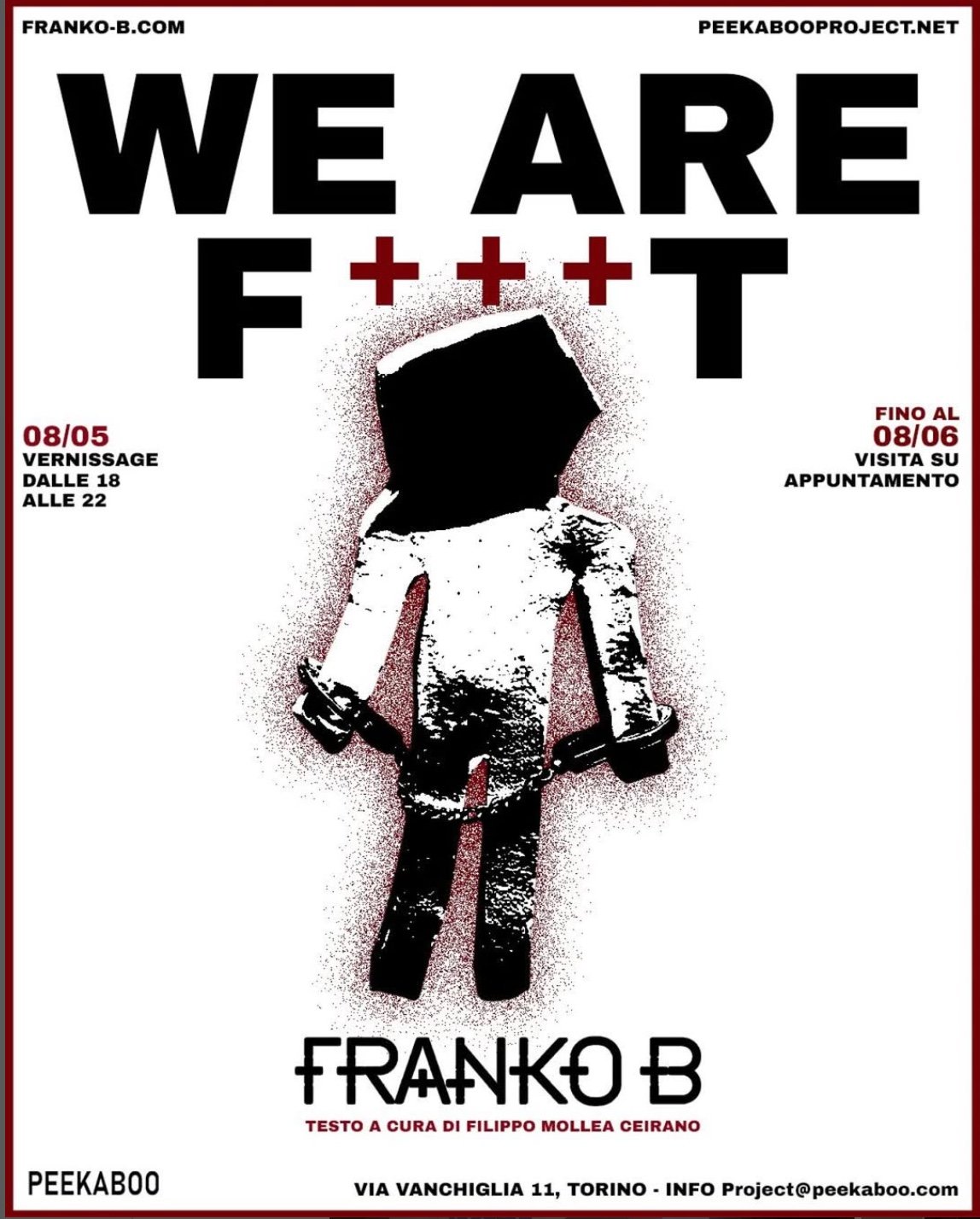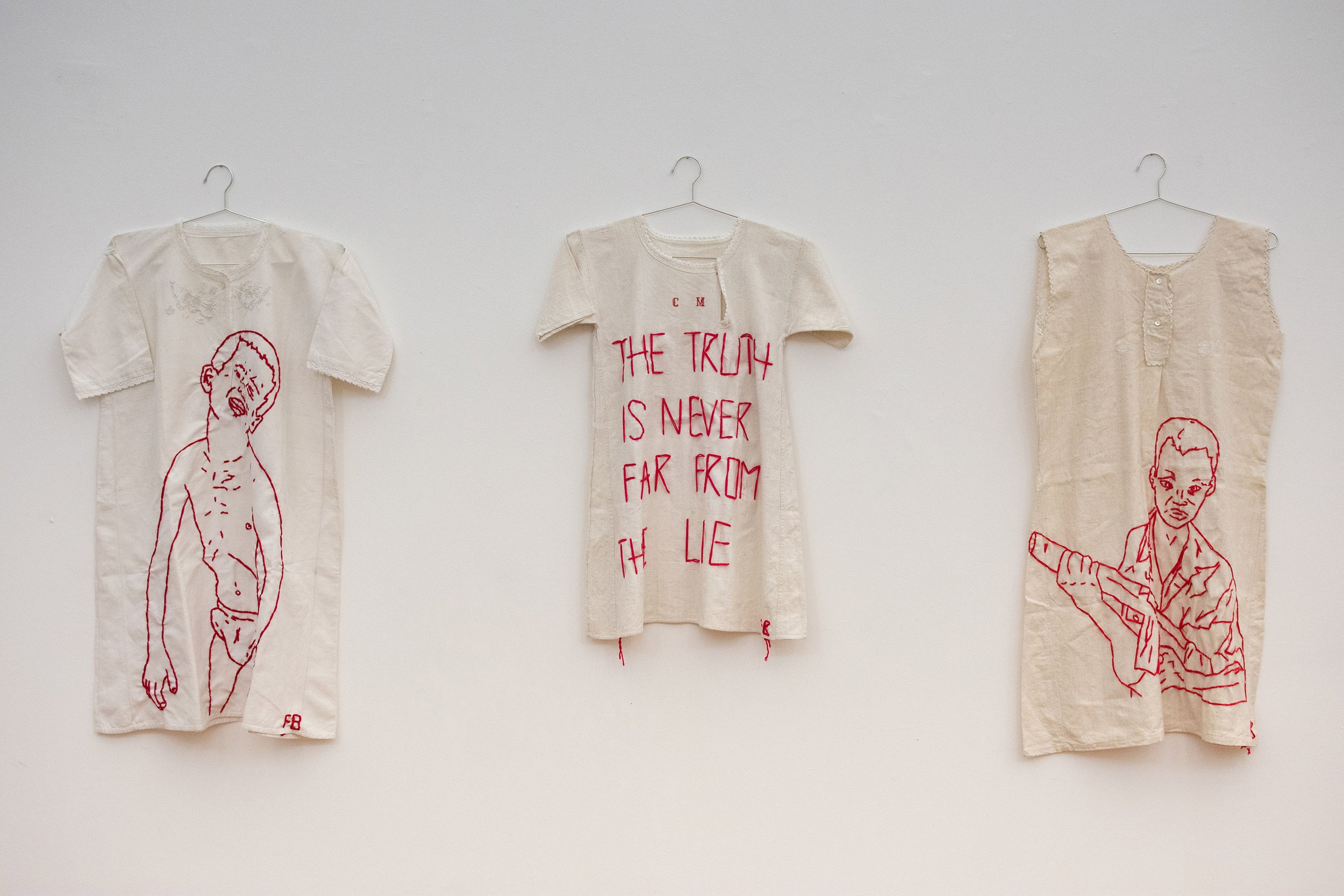Conscious of Being Fuckt
Filippo Mollea Ceirano (2025)
(exhibition text for Franko B: We are F++t at Peekaboo Project Space, Turin (2025))
Among the many shortcomings afflicting contemporary art, one that certainly stands out is the fact that we talk too much about it, and more importantly, we talk about it poorly, superficially and redundantly. Whether it’s analogue or virtual, every opportunity is a good one to fill up pages with inane ramblings which in no way enriches the reading of the artist or his project, and instead gratifies the writer’s self-referential ambitions. For the lucky ones, it is also a way – if not honest, at least not illegal – to collect a payment that is usually rather meagre, considering the fact that it’s received in exchange for nothing. But it’s still something. In some cases, one almost has the feeling that the artists themselves leave room for critics and curators to come up with productions that are forcibly cryptic, in need of additions and clarifications, in order to open up a gap for mediation and thus provide a context that is functional to the system.
Franko B’s terrain, conversely, can become a minefield; if you’re not careful, it is immediately obvious that you’ve written worthless or plain nonsense. His works speak for themselves, they tell all they have to say by themselves. His research isn’t grasping at some kind of expressive code, it doesn’t leave any room for elitist languages or symbolisms. It aims for the primary objective in the most direct and immediate way: sharing and laying bare his vision of the world, the meaning of life, of what is happening, of what we need to have a critical conscience about. This occurs through a constant dialogue between the private sphere, which draws on his personal experience, and everything around us that touches and penetrates it. Basically, at a time when communication – in the sense of a mutual exchange of ideas, stimuli, sensations and impressions – is increasingly being replaced by its authoritarian alternative, information – i.e. the one-directional transmission of data and interpretations – Franko raises the challenge in terms of empathy, sharing, encounter; or even conflict, as long as it’s understood as a vital dynamic, as a confrontation that benefits all parties, not as an attempt to prevail one over the other.
Therefore taking part in one of his performances or visiting one of his exhibitions is an experience requiring a different, unusual approach to what we are used to for similar events. It’s not a representation, nor a storytelling, let alone a parade of objects intended for “consumption”. In this present case, images, words, symbols and visual effects aim to question the comforting certainties on which our lives end up slumbering; through a series of very recent works, within an unusual space (neither a gallery nor a museum, but rather a workshop/atelier in which the separation between thought, production and fruition gets blurred) they seek an engaging effect that could be defined as “critical emotion”.
We are living in an era full of uncertainties, atrocities, conflicts, in which there’s a resurgence of a cruelty that our generations thought they could permanently dismiss, in the illusory utopia spread by the media manipulated by an increasingly cynical and mystifying control. The exhibition WE ARE F***T pours salt on these wounds.
Violence and conflicts around the world are thus approached in an extremely crude way through images or ideas taken from media reports, portrayed with essential outlines embroidered on old dressing gowns or white tunics: child soldiers, armed guerrilla fighters, wounded bodies or short written warnings evoke the difficult reality of our times – often dismissed or diluted in the regime’s rhetoric – through an unfamiliar and anti-conventional language that goes back to the origins of the artist’s personal experience, what one might call “punk sensibility”. Actually, the punks of the early days would typically characterise their clothes with provocative statements and images of protest and rejection of the hypocritical conformism to an unacceptable society, in front of which they could only present themselves in a totally unacceptable manner.
Another engaging work is a sculpture showing the body of a child entirely covered in gold, with very realistic features, lying abandoned, lifeless, with his trousers down below the knee: he could be the victim of a bombing, or a migrant who has not survived the hardships of the journey, or even the victim of violent abuse covered by the hypocrisies of the conformist bourgeois society, but it doesn’t matter. What matters is to point the finger at a world in which childhood is constantly exposed to the ravages of an organisation founded on cynicism and on the crystallisation of the privileges of class-economics.
Adding to the list of causes of widespread distress there is also a direct reference to the centres of power, condensed in Franko’s most complex work, The Last Supper. It is a polyptych of thirteen canvases depicting the faces of the most powerful political and economic figures, with a clear reference to the conceptual reversal of one of the central moments in the construction of the ideological pillars of modern society. In the Gospel’s Last Supper, the key elements – both positive and negative – with which we must come to terms on a daily basis are all gathered round: conviviality, togetherness, betrayal, sacrifice, taking the blame, greed, remorse. In the sacred texts, these elements were directed towards a liberating purpose, while now they have become features endorsing an increasingly intrusive apparatus of control and subjugation.
Two other works have a strong visual and evocative impact, both with a more direct reference to Franko’s personal sphere. One is the large installation called L’Italia rotta (Broken Italy), a composition that takes shape differently each time, depending on the available space, orientation and materials. It is a reproduction of the peninsula and its larger islands, set up with shards and fragments of pottery broken over time for various causes. The other work is a large cross, a recurring symbol in Franko’s research, cut out from an oxidised sheet of iron. It is a recurring icon, repeatedly tattooed on the artist’s own body and which, due to the complexity of its references, well summarises many of the central aspects of his overall reasoning. First of all, it has a general value, known all over the world, as a reference to Christian sacrifice, martyrdom, and expiation of guilt. But also as the sign (a red cross) used to identify premises such as hospitals, collection centres, emergency vehicles and facilities, which even in the most bitter conflicts must be (or should be) respected. Let’s leave aside any comment on what has remained of this almost human form of respect and move on. Because, as we said, in Franko’s work, the personal dimension is never separated or disconnected from the rest, from society, from the established powers, from institutions. And for him, the red cross was – and still is – the mark that identifies those institutions which, especially in the most crucial moments of his childhood, should have provided support, backing, protection, but actually turned out to be places of abuse, exploitation, humiliation and neglect. Therefore it becomes a way of revealing the truth through its falsification.
As a whole, the exhibition creates a setting that speaks through different languages, in which the artist’s own sensitivity is however always clearly recognisable; it doesn’t provide answers, it doesn’t express a point of view, but rather a feeling, or more precisely a combination of feelings, of states of mind that try to challenge any form of approval, or just resignation, towards everything that is going wrong.
Turin, 16 April 2025
exhibition:
-

• We Are F+++T
Peekaboo Project Space, Turin (2025)
related works:
-

• The Last Supper
series of stitch drawings on unprimed linen canvases (2024)
-

• Here Comes The Rain
series of stitch drawings on vintage nightshirts (2023-2025)
-

• Sleeping Beauty Version 4
sculpture (2025)
-

• Broken
ceramic installation (2019)
